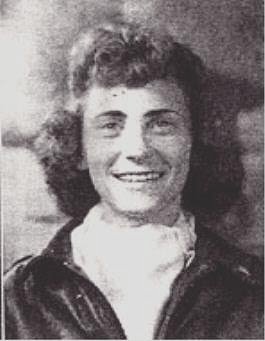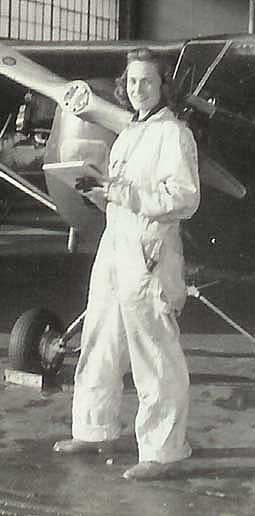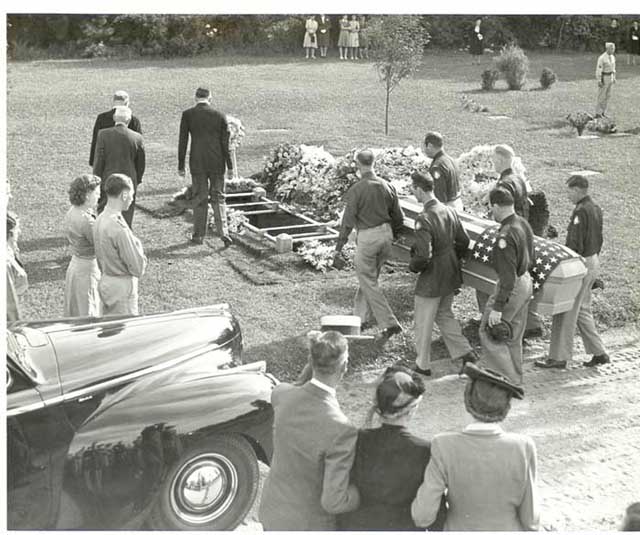 Mabel Virginia Rawlinson
Mabel Virginia Rawlinson
March 19, 1917 – August 23, 1943
Class 43-W-3
Entered Army Air Force flight training: Houston Municipal Airport, Houston, Texas, January 15, 1943
Graduated: Avenger Field, Sweetwater, Texas, July 3, 1943
Training location: Houston Municipal Airport (Tex.) and Avenger Field (Sweetwater, Tex.)
Assigned bases: New Castle Army Air Base (Wilmington, Del.)
Planes flown: A-24
Mabel Rawlinson was one of the 38 WASP who would die during the war, many from plane mechanical failures.
Mabel Rawlinson was a college graduate, a lovely, lively and witty young woman, a pilot, and a heroine, who sacrificed her life while serving her country in World War II. Her parents and many friends suffered such loss when Mabel died at just age 26. Her brothers and sisters never stopped missing Mabel’s smiles, thoughtfulness and fun-loving enthusiasm; Mabel’s vitality seemed so absent from all family gatherings in the 60 years since she died.
Mabel was born in 1917 in a pine tree forest in Greenwood, near Dover, Delaware. In 1925, at age 8, she and her family moved near Blackstone, Nottoway County, Virginia, where they lived a simple rural life down a red clay country road called Cellar Creek Road. Mabel helped her mother with the gardening, housework, sewing, cooking and baking. There were animals to feed, books to read, talent shows, church activities and outdoor adventures.
During the Great Depression, Mabel’s mother supported their family with her rural schoolteacher’s salary. It was the early 1930s. Mabel hoed and raked in the family’s cultivated fields, fed the chickens, socialized with friends and made good grades in school. After graduating from high school in Virginia in 1935, Mabel moved to Kalamazoo, Michigan, where her aunt, Eleanor Rawlinson, was an English professor. Living with her aunt, Mabel attended college classes and worked in the college Health Service.
Graduating with a Bachelor of Arts degree in 1939 from Western Michigan University, Mabel worked in the Kalamazoo Plating Works and the Kalamazoo

Mabel Rawlinson at Kalamazoo Airport 1941
Public Library. In 1940, she received her first flying lesson and returned to Western Michigan University to take post-graduate civilian pilot training courses, then recently opened to women. On October 31st, 1940, Mabel soloed for the first time. While still working at the library, she joined the Aviatrix Club, achieved her private pilot license and spent most of her free time at the Kalamazoo airport. By 1941, Mabel had become co-owner of an Aeronica Chief airplane in Kalamazoo.
When the Japanese bombed Pearl Harbor and the US entered World War II at the end of 1941, the government initially banned all private flights for national security reasons. Determined to stay in the air, at the end of 1941, Mabel and other Kalamazoo pilots promptly formed the Civil Air Patrol in Kalamazoo. That next year, 1942, was a great year for Mabel – she was flying her Aeronica Chief every week and proudly wearing the uniform of the Civil Air Patrol.
It was around September 1942 that word reached Kalamazoo that the Army Air Corps would be recruiting female pilots to assist in the war effort. The demand for male combat pilots and warplanes had left the Air Transport Command with a shortage of experienced pilots. General Henry “Hap” Arnold, Commanding General of the Army Air Forces, approved a program that would train a large group of women to serve as ferrying pilots with the training school placed under the direction of Jacqueline Cochran. These women would be trained to fly all of the US warplanes and would assist with ferrying planes from factories to bases, towing targets for ground troop practice and training new pilots.
These new volunteer female pilots would make it possible for male pilots to relinquish their stateside duties and assist in war efforts overseas, where they were greatly needed. So, 1,857 young women pilots from all over the United States quit their jobs and left the safety of their homes and families to go to Texas. They traveled by car, bus, train, or by plane. Some hitchhiked and all paid their own way to get there. The women joined up with the Army Air Forces because they loved to fly and because their country needed them.
Mabel reported on January 15, 1943 at Avenger Field in Sweetwater, Texas, for her Army Air Force pilot training. Excerpted from a letter she wrote to her sister Georgian, April 18, 1943, Mabel said, “It began to occur to me if I’m going to write you while I’m still in the 319th Army Air Forces Flying Training Detachment, I’d better start. One of my three roommates is home packing up her things today – washed out, she is. Had her Army check ride yesterday, and the Lieutenant recommended for her elimination. I’ll be having my next Army ride any day now, so maybe I’ll be packing up too… If I should get through (our class graduation in about 2 months), I’ll have a 10-day vacation before I go to my post (and if I have my choice, it’ll be California), and a bunch of us are planning to go down to Mexico. I had my first instrument time today. It’s fun but a lot of work. The class ahead of us is having night flying now. It must be beautiful up there these nights, the moon is shining. Newsreels are going to be made of the occasion (of our graduation)… Maybe you’ll see the newsreel in Baltimore. My latest (boyfriend) is named John… He’s 6’1″, 200 lbs, a couple of dimples and exceptionally nice. I think he’s overseas now though. He’s in the air corps, combat unit, also he’s an engine specialist. I went to see him one weekend in San Antonio. We had a good time. Went all through the Alamo, etc… Guess I’d better write home now. If I don’t write every week, Mother thinks I’ve cracked up for sure. Write. So long, Mabel.”
After receiving her wings and completing her basic training in the WFTD Class 43-W-3 at Sweetwater, Texas, July 1943, Mabel took a short R&R in Mexico with friends. Then, following Army orders, Mabel reported to Camp Davis Army Air Field in North Carolina for advanced training. On August 5, 1943, the WAFS and the WFTD were merged and were re-designated the Women Airforce Service Pilots, or WASP.
Camp Davis was her last post. Mabel Rawlinson soon became one of the very special women who served and died as pilots for the Air Force in World War II. It was at Camp Davis on August 23, 1943 that Mabel lost her life when her airplane crashed and was consumed by flames. Since WASP were technically considered volunteer civilian pilots and not Air Force pilots, no monetary compensation was available to the Rawlinson family for her funeral expenses. The other female pilots at Camp Davis pooled their extra money and assisted in the expense of transporting Mabel’s casket back to Kalamazoo for burial. There, her casket was draped with an American flag and the Kalamazoo Civil Air Patrol honored her with buglers, fly-overs and solemn gun salutes. Mabel was one of 38 military women who lost their lives serving as WASP during the duration of World War II. WASP were not given full military status until many years later, many decades after WWII. Today, a monument at Sweetwater, Texas, commemorates their service to the Air Force.
The planes used for training and flown by the WASP were aircraft that had been returned from combat duty and were minimally maintained due to lack of parts. The following is based on the text from the Army Air Force accident report No. 129, dated September 4, 1943. Craig Fuller of Aviation Archaeological Investigation & Research provided the report: “Mabel was on a night training flight with her instructor 2nd Lt. Harvey J. Robillard. This was her first night flight at this base and it was about 9 PM. Prior to this flight, Mabel had accumulated just over 200 hours of flight time in the WASP. This was in addition to her flying time prior to joining the WASP. A little over 10 of these hours were in an A-24 like the one they were flying this night at Camp Davis, North Carolina.”
According to the report, take-off and flight were normal until just before they started to land.
The following is based on the text from the Army Air Force accident report No. 129, dated September 4, 1943. The report was provided by Craig Fuller of Aviation Archaeological Investigation & Research.
Mabel was on a night training flight with her instructor 2nd Lt. Harvey J. Robillard. This was her first night flight at this base and it was about 9 PM.
Prior to this flight, Mable had accumulated just over 200 hours of flight time in the WASP. This was in addition to her flying time prior to joining the WASP. A little over 10 of these hours were in an A-24 like the one they were flying this night at Camp Davis, North Carolina.
According to the report, take-off and flight were normal until just before they started to land. In addition to the statement from the instructor, there were two other witness statements concerning the final moments of the flight.
Frank J. Fitzgibbon, WO (Jg), was standing on the ramp in front of the hanger when the plane flew over during its attempted landing. He noted that based on “the sound and appearance of flames, the engine was operating on an extremely lean mixture. In my opinion, the airplane was not on fire, and crashed with the engine still operating.”
Staff Sergeant John A. Ross stated that while cleaning the day room, he “heard a plane overhead missing badly. The plane seemed to be unordinarily lit up by flames coming from the exhaust stacks.”
According to 2nd Lt. Robillard, who was seriously injured during the crash, “We were circling 2,000 feet at South Zone at about 2100. The tower called and told us to shoot a landing on Runway 4. She entered the pattern normal way at 1100 feet and cut gun to let wheels down. Soon it seemed something was wrong. I felt the throttle moving back and forth and realized the engine was dead. By that time, we had 700 feet and were across runway and there turning to the left. I took over and told the student to jump. I then shouted at the student to jump. I had little time to look and see if she jumped. Somehow, I knew she hadn’t. I attempted to bring the plane in for a crash landing on the end of Runway 4. The next thing I felt the airplane shudder and I remember no more.”
The AAF report summarized these statements and possibly others with the following: “Halfway through the first 90-degree turn to the left the safety pilot took over and attempted to bring the plane in wheels down. He ordered the woman pilot to jump. He finished the first 90-degree turn, flew an abbreviated down wind and base leg, and was trying to round out a turn on to final approach when the plane crashed into the trees from a half stall in turn at low altitude. The plane broke into halves at the fuselage at the point of the rear cockpit. The safety pilot was thrown clear but the plane burned. The woman pilot did not jump and was burned to death strapped in the cockpit. The wrecked plane rests about 300 yards from the end of Runway 4. A wide drainage ditch and jungle like trees and swamp undergrowth handicapped rescue efforts.”
There is no mention in this report of a faulty latch in the front cockpit where Mabel was seated. This faulty latch is referred to in other WASP books and in a message from Mabel’s sister.
Jacqueline Cochran, Director of the WASP, sent this telegram to Mabel’s family, in August 1943, “I hope this will convey to you how deeply we all feel about Mabel’s accident. May God give you strength to find comfort in the fact that when she was called to make the supreme sacrifice, she was serving her country in the highest capacity permitted women today.”
These words were spoken by General Henry H. Arnold, Commanding General Army Air Forces, December 7, 1944, at Avenger Field, Sweetwater, Texas: “The WASP have completed their mission. Their job has been successful. But as is usual in war, the cost has been heavy. Thirty-eight WASP have died while helping their country move toward the moment of final victory. The Air Forces will long remember their service and their final sacrifice.”
On January 18th, 1945, General Arnold wrote this to Mabel’s mother, Nora Belle Rawlinson, “Dear Mrs. Rawlinson, During the Army Air Forces’ tribute to the Women Air forces Services Pilots at Sweetwater, Texas, on 7 December 1944, a plaque was dedicated to the memory of those WASP who died while serving their country… Realizing that you may not have an opportunity to see the plaque and knowing that you would treasure such a memorial to your daughter, I am enclosing a photographic copy of it… There is little I can say to console you in the loss of your daughter, but I trust the memory of her devotion to her country will bring some measure of solace. And I urge you to remember that she… left a brave heritage to America – heritage of faith in victory and faith in the ultimate freedom of humanity. My heartfelt sympathy is extended to you.”
A family friend, Miss Ellis J. Walker, of Western Michigan University’s Health Service said of Mabel’s mother, Nora: “No one held head higher than Nora Rawlinson as we learned that Mabel was doing night flying, that she was piloting bombers, that the accident which brought her death was no fault of hers, and that as a good soldier she had taken the risk, played her part, and met her fate.
In the years since 1943, many different explanations have been offered by historians regarding the cause of Mabel’s tragedy. One re-occurring explanation is that the gas tank of her plane had been sabotaged with table sugar, the deed of angry male pilots who resented the females taking over their stateside jobs. Another documented account asserts that the night Mabel died that she had been mistakenly hit by “friendly fire”, a result of towing targets behind her plane for practicing ground troops that were firing real ammunition.

Mabel’s August 1943 burial in Kalamazoo. Her father, mother and sister Margaret are standing in the foreground as the casket passes. Behind them is a long procession of colleagues, family and friends
Sources:





